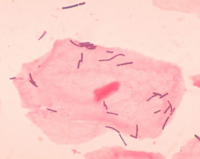Lactobacillus acidophilus
For the course duration, the article is closed to outside editing. Of course you can always leave comments on the discussion page. The anticipated date of course completion is May 21, 2009. One month after that date at the latest, this notice shall be removed. Besides, many other Citizendium articles welcome your collaboration! |
| Lactobacillus acidophilus | ||||||||||||||
|---|---|---|---|---|---|---|---|---|---|---|---|---|---|---|
 | ||||||||||||||
| Scientific classification | ||||||||||||||
| ||||||||||||||
| Binomial name | ||||||||||||||
| Lactobacillus acidophilus |
Description and significance
Lactobacillus acidophilus is a species of gram-positive bacteria commonly used in dairy production. L. acidophilus is also one of the most common forms of probiotics, which are "friendly bacteria".[1] L. acidophilus is found in the human and animal gut, mouth, and vagina. It functions as a lactic acid producer, by metabolizing lactose to lactic acid. The acid produced by L. acidophilus can control the growth of the fungus Candida albicans, which is the cause of Oral thrush and vaginal yeast infections.[2][3] The acid produced can also prevent unwanted organisms living in the gut. L. acidophilus has been shown to drastically reduce E. coli in cattle.[4] L. acidophilus is commonly used in the production of yogurt, where it is labeled as an active or live culture. People that are lactose intolerant are able to digest dairy products containing L. acidophilus better than dairy products without it.[5] Selected strains of L. acidophilus have shown significant reductions of cholesterol in humans, lowering the risk of coronary heart disease.[6]
Genome structure
The complete genome of Lactobacillus acidophilus NCFM contains 1,993,564 nucleotides and has no plasmids. Its average GC content is 34.71% and 1,864 ORFs were predicted. 72.5% of the open reading frames (ORFs) were classified as functional. Several proteins which allowed L. acidophilus to survive in the gut were identified. These proteins included gene clusters that allowed the transport of a diverse group of carbohydrates, including fructooligosaccharides and raffinose. 9 two-component regulatory systems were predicted, which involved in bacteriocin production and acid tolerance.[7]
Cell structure and metabolism
L. acidophilus is rod-shaped and gram-positive. It grows in anaerobic, low pH (<5.0) conditions with an optimal growth temperature of 30˚C. It can only undergo fermentation. L. acidophilus is homofermentative, meaning that it can only produce lactic acid from fermentation. Because it needs sugar for fermentation, it inhabits environments rich in sugar, such as the human and animal gut.
Ecology
L. acidophilus keeps the environment in the gut free from harmful organisms by lowering the pH of the environment, and by producing bacteriocins, which attack the harmful bacteria. It is also suggested that L. acidophilus decreases lactose intolerance since it aids in the metabolism of lactose.
Pathology
L. acidophilus is non-pathogenic.
Application to Biotechnology
L. acidophilus is frequently used in the production of dairy products, such as yogurt. The added health benefits associated with L. acidophilus allow more yogurt to be bought and consumed, thus affecting the economy in a positive manner. "L. acidophilus" allows more people to live healthier lives, and allow people with lactose intolerance to enjoy dairy products.
Current Research
References
http://www.umm.edu/altmed/articles/lactobacillus-acidophilus-000310.htm [1]
http://jds.fass.org/cgi/reprint/63/5/830.pdf [2]
http://www.ebi.ac.uk/2can/genomes/bacteria/Lactobacillus_acidophilus.html [3]
http://ard.unl.edu/rn/0902/ecoli.html [4]
http://jds.fass.org/cgi/content/abstract/66/5/959 [5]
http://www.jacn.org/cgi/reprint/18/1/43.pdf [6]
http://www.pnas.org/content/102/11/3906.full.pdf+html [7]
- ↑ http://www.umm.edu/altmed/articles/lactobacillus-acidophilus-000310.htm
- ↑ http://jds.fass.org/cgi/reprint/63/5/830.pdf
- ↑ http://www.ebi.ac.uk/2can/genomes/bacteria/Lactobacillus_acidophilus.html
- ↑ http://ard.unl.edu/rn/0902/ecoli.html
- ↑ http://jds.fass.org/cgi/content/abstract/66/5/959
- ↑ http://www.jacn.org/cgi/reprint/18/1/43.pdf
- ↑ http://www.pnas.org/content/102/11/3906.full.pdf+html